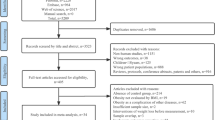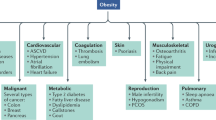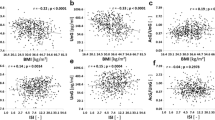Abstract
The high prevalence of obesity and diabetes will lead to higher rates of morbidity and mortality. The search for drugs to treat these metabolic disorders has, therefore, intensified. The stomach-derived peptide ghrelin regulates food intake and body weight. Recent work suggests that ghrelin also controls glucose metabolism. In addition, current evidence suggests that most of the actions of ghrelin could contribute to the metabolic syndrome. The ghrelin signaling system is, therefore, a promising target for the development of new drugs for the treatment of obesity and diabetes. Agents that block the ghrelin signaling system might be especially useful targets. This Review summarizes the potential and the limitations of ghrelin as a tool to better understand, prevent and treat obesity and diabetes.
Key Points
-
Ghrelin is a peptide hormone derived from the stomach and gastrointestinal tract that predominantly controls energy balance and glucose homeostasis
-
Ghrelin mainly affects metabolism through the G-protein-coupled growth hormone secretagogue receptor 1a (GHS-R1a) in the brain
-
Pharmacologic ghrelin treatment in rodents leads to sustained gain of fat mass induced by increased food intake, decreased fat oxidation rates, altered nutrient partitioning, increased lipogenesis in adipose tissue and decreased thermogenesis
-
Ghrelin-deficient mouse models possess improved peripheral insulin sensitivity, and descriptive studies in humans and rodents suggest an inverse relationship between plasma ghrelin levels and insulin resistance and type 2 diabetes
-
Constituting a classical combination of a peptide hormone and a G-protein-coupled receptor (with additional ligands and receptors possibly to be discovered), there is reasonable potential to target the ghrelin–GHS-R system pharmacologically, whereas possible GHS-R1a-independent ghrelin effects represent a less defined and more complicated target
This is a preview of subscription content, access via your institution
Access options
Subscribe to this journal
Receive 12 print issues and online access
$209.00 per year
only $17.42 per issue
Buy this article
- Purchase on Springer Link
- Instant access to full article PDF
Prices may be subject to local taxes which are calculated during checkout

Similar content being viewed by others
References
Heijboer AC et al. (2006) Gut-brain axis: regulation of glucose metabolism. J Neuroendocrinol 18: 883–894
van der Lely AJ et al. (2004) Biological, physiological, pathophysiological, and pharmacological aspects of ghrelin. Endocr Rev 25: 426–457
Diano S et al. (2006) Ghrelin controls hippocampal spine synapse density and memory performance. Nat Neurosci 9: 381–388
Despres JP and Lemieux I (2006) Abdominal obesity and metabolic syndrome. Nature 444: 881–887
Nogueiras R et al. (2006) Growth hormone secretagogue (ghrelin-) receptors—a complex drug target for the regulation of body weight. CNS Neurol Disord Drug Targets 5: 335–343
Kojima M et al. (1999) Ghrelin is a growth-hormone-releasing acylated peptide from stomach. Nature 402: 656–660
Hosoda H et al. (2003) Structural divergence of human ghrelin. Identification of multiple ghrelin-derived molecules produced by post-translational processing. J Biol Chem 278: 64–70
Nishi Y et al. (2005) Ingested medium-chain fatty acids are directly utilized for the acyl modification of ghrelin. Endocrinology 146: 2255–2264
Camina JP (2006) Cell biology of the ghrelin receptor. J Neuroendocrinol 18: 65–76
Gauna C et al. (2006) Unacylated ghrelin is active on the INS-1E rat insulinoma cell line independently of the growth hormone secretagogue receptor type 1a and the corticotropin releasing factor 2 receptor. Mol Cell Endocrinol 251: 103–111
Granata R et al. (2007) Acylated and unacylated ghrelin promote proliferation and inhibit apoptosis of pancreatic β-cells and human islets: involvement of 3′,5′-cyclic adenosine monophosphate/protein kinase A, extracellular signal-regulated kinase 1/2, and phosphatidyl inositol 3-kinase/Akt signaling. Endocrinology 148: 512–529
Sun Y et al. (2004) Ghrelin stimulation of growth hormone release and appetite is mediated through the growth hormone secretagogue receptor. Proc Natl Acad Sci USA 101: 4679–4684
Holst B et al. (2003) High constitutive signaling of the ghrelin receptor—identification of a potent inverse agonist. Mol Endocrinol 17: 2201–2210
Zhang JV et al. (2005) Obestatin, a peptide encoded by the ghrelin gene, opposes ghrelin's effects on food intake. Science 310: 996–999
Sibilia V et al. (2006) Intracerebroventricular acute and chronic administration of obestatin minimally affect food intake but not weight gain in the rat. J Endocrinol Invest 29: RC31–RC34
Bresciani E et al. (2006) Obestatin inhibits feeding but does not modulate GH and corticosterone secretion in the rat. J Endocrinol Invest 29: RC16–RC18
Holst B et al. (2007) GPR39 signaling is stimulated by zinc ions but not by obestatin. Endocrinology 148: 13–20
Seoane LM et al. (2006) Central obestatin administration does not modify either spontaneous or ghrelin-induced food intake in rats. J Endocrinol Invest 29: RC13–RC15
Nogueiras R et al. (2007) Effects of obestatin on energy balance and growth hormone secretion in rodents. Endocrinology 148: 21–26
Gourcerol G and Tache Y (2007) Obestatin—a ghrelin-associated peptide that does not hold its promise to suppress food intake and motility. Neurogastroenterol Motil 19: 161–165
Dun SL et al. (2006) Distribution and biological activity of obestatin in the rat. J Endocrinol 191: 481–489
Samson WK et al. (2007) Obestatin acts in brain to inhibit thirst. Am J Physiol Regul Integr Comp Physiol 292: R637–R643
Szentirmai E and Krueger JM (2006) Obestatin alters sleep in rats. Neurosci Lett 404: 222–226
Lauwers E et al. (2006) Obestatin does not activate orphan G protein-coupled receptor GPR39. Biochem Biophys Res Commun 351: 21–25
Tolle V et al. (2002) Ultradian rhythmicity of ghrelin secretion in relation with GH, feeding behavior, and sleep-wake patterns in rats. Endocrinology 143: 1353–1361
Cummings DE et al. (2001) A preprandial rise in plasma ghrelin levels suggests a role in meal initiation in humans. Diabetes 50: 1714–1719
Tschop M et al. (2000) Ghrelin induces adiposity in rodents. Nature 407: 908–913
Tschop M et al. (2001) Post-prandial decrease of circulating human ghrelin levels. J Endocrinol Invest 24: RC19–RC21
Overduin J et al. (2005) Role of the duodenum and macronutrient type in ghrelin regulation. Endocrinology 146: 845–850
Ariyasu H et al. (2002) Delayed short-term secretory regulation of ghrelin in obese animals: evidenced by a specific RIA for the active form of ghrelin. Endocrinology 143: 3341–3350
Gottero C et al. (2004) Ghrelin: a link between eating disorders, obesity and reproduction. Nutr Neurosci 7: 255–270
Perreault M et al. (2004) Resistance to the orexigenic effect of ghrelin in dietary-induced obesity in mice: reversal upon weight loss. Int J Obes Relat Metab Disord 28: 879–885
Yildiz BO et al. (2004) Alterations in the dynamics of circulating ghrelin, adiponectin, and leptin in human obesity. Proc Natl Acad Sci USA 101: 10434–10439
English PJ et al. (2002) Food fails to suppress ghrelin levels in obese humans. J Clin Endocrinol Metab 87: 2984
Purnell JQ et al. (2007) Changes in 24-h area-under-the-curve ghrelin values following diet-induced weight loss are associated with loss of fat-free mass, but not with changes in fat mass, insulin levels or insulin sensitivity. Int J Obes (Lond) 31: 385–389
Sun Y et al. (2003) Deletion of ghrelin impairs neither growth nor appetite. Mol Cell Biol 23: 7973–7981
Lawrence CB et al. (2002) Acute central ghrelin and GH secretagogues induce feeding and activate brain appetite centers. Endocrinology 143: 155–162
Chen HY et al. (2004) Orexigenic action of peripheral ghrelin is mediated by neuropeptide Y and agouti-related protein. Endocrinology 145: 2607–2612
Tschop M et al. (2002) GH-releasing peptide-2 increases fat mass in mice lacking NPY: indication for a crucial mediating role of hypothalamic agouti-related protein. Endocrinology 143: 558–568
Shuto Y et al. (2002) Hypothalamic growth hormone secretagogue receptor regulates growth hormone secretion, feeding, and adiposity. J Clin Invest 109: 1429–1436
Egecioglu E et al. (2006) Growth hormone receptor deficiency results in blunted ghrelin feeding response, obesity, and hypolipidemia in mice. Am J Physiol Endocrinol Metab 290: E317–E325
Banks WA et al. (2002) Extent and direction of ghrelin transport across the blood-brain barrier is determined by its unique primary structure. J Pharmacol Exp Ther 302: 822–827
Cowley MA et al. (2003) The distribution and mechanism of action of ghrelin in the CNS demonstrates a novel hypothalamic circuit regulating energy homeostasis. Neuron 37: 649–661
Kineman RD et al. (2007) Identification of a mouse ghrelin gene transcript that contains intron 2 and is regulated in the pituitary and hypothalamus in response to metabolic stress. J Mol Endocrinol 38: 511–521
Horvath TL (2006) Synaptic plasticity in energy balance regulation. Obesity (Silver Spring) 14 (Suppl 5): 228S–233S
Olszewski PK et al. (2003) Hypothalamic paraventricular injections of ghrelin: effect on feeding and c-Fos immunoreactivity. Peptides 24: 919–923
Currie PJ et al. (2005) Ghrelin is an orexigenic and metabolic signaling peptide in the arcuate and paraventricular nuclei. Am J Physiol Regul Integr Comp Physiol 289: R353–R358
Olszewski PK et al. (2003) Neural basis of orexigenic effects of ghrelin acting within lateral hypothalamus. Peptides 24: 597–602
Faulconbridge LF et al. (2003) Hyperphagic effects of brainstem ghrelin administration. Diabetes 52: 2260–2265
Naleid AM et al. (2005) Ghrelin induces feeding in the mesolimbic reward pathway between the ventral tegmental area and the nucleus accumbens. Peptides 26: 2274–2279
Guan XM et al. (1997) Distribution of mRNA encoding the growth hormone secretagogue receptor in brain and peripheral tissues. Brain Res Mol Brain Res 48: 23–29
Zigman JM et al. (2006) Expression of ghrelin receptor mRNA in the rat and the mouse brain. J Comp Neurol 494: 528–548
Abizaid A et al. (2006) Ghrelin modulates the activity and synaptic input organization of midbrain dopamine neurons while promoting appetite. J Clin Invest 116: 3229–3239
Date Y et al. (2002) The role of the gastric afferent vagal nerve in ghrelin-induced feeding and growth hormone secretion in rats. Gastroenterology 123: 1120–1128
Asakawa A et al. (2001) Ghrelin is an appetite-stimulatory signal from stomach with structural resemblance to motilin. Gastroenterology 120: 337–345
Arnold M et al. (2006) Gut vagal afferents are not necessary for the eating-stimulatory effect of intraperitoneally injected ghrelin in the rat. J Neurosci 26: 11052–11060
Wortley KE et al. (2004) Genetic deletion of ghrelin does not decrease food intake but influences metabolic fuel preference. Proc Natl Acad Sci USA 101: 8227–8232
Erickson JC et al. (1996) Sensitivity to leptin and susceptibility to seizures of mice lacking neuropeptide Y. Nature 381: 415–421
Qian S et al. (2002) Neither agouti-related protein nor neuropeptide Y is critically required for the regulation of energy homeostasis in mice. Mol Cell Biol 22: 5027–5035
Theander-Carrillo C et al. (2006) Ghrelin action in the brain controls adipocyte metabolism. J Clin Invest 116: 1983–1993
Dornonville de la Cour C et al. (2005) Ghrelin treatment reverses the reduction in weight gain and body fat in gastrectomised mice. Gut 54: 907–913
Zorrilla EP et al. (2006) Vaccination against weight gain. Proc Natl Acad Sci USA 103: 13226–13231
St-Pierre DH et al. (2004) Relationship between ghrelin and energy expenditure in healthy young women. J Clin Endocrinol Metab 89: 5993–5997
Yasuda T et al. (2003) Centrally administered ghrelin suppresses sympathetic nerve activity in brown adipose tissue of rats. Neurosci Lett 349: 75–78
Tang-Christensen M et al. (2003) Ghrelin induces long lasting changes in food intake and locomotor behaviour. Abstract P3-94 presented at the 85th Annual Meeting of the Endocrine Society: 2003, June 19–22, Philadelphia, PA
Tang-Christensen M et al. (2004) Central administration of ghrelin and agouti-related protein (83-132) increases food intake and decreases spontaneous locomotor activity in rats. Endocrinology 145: 4645–4652
Barazzoni R et al. (2005) Ghrelin regulates mitochondrial-lipid metabolism gene expression and tissue fat distribution in liver and skeletal muscle. Am J Physiol Endocrinol Metab 288: E228–E235
McCowen KC et al. (2002) Circulating ghrelin concentrations are lowered by intravenous glucose or hyperinsulinemic euglycemic conditions in rodents. J Endocrinol 175: R7–R11
Saad MF et al. (2002) Insulin regulates plasma ghrelin concentration. J Clin Endocrinol Metab 87: 3997–4000
Purnell JQ et al. (2003) Ghrelin levels correlate with insulin levels, insulin resistance, and high-density lipoprotein cholesterol, but not with gender, menopausal status, or cortisol levels in humans. J Clin Endocrinol Metab 88: 5747–5752
Broglio F et al. (2001) Ghrelin, a natural GH secretagogue produced by the stomach, induces hyperglycemia and reduces insulin secretion in humans. J Clin Endocrinol Metab 86: 5083–5086
Broglio F et al. (2004) Non-acylated ghrelin counteracts the metabolic but not the neuroendocrine response to acylated ghrelin in humans. J Clin Endocrinol Metab 89: 3062–3065
Sun Y et al. (2006) Ablation of ghrelin improves the diabetic but not obese phenotype of ob/ob mice. Cell Metab 3: 379–386
Zigman JM et al. (2005) Mice lacking ghrelin receptors resist the development of diet-induced obesity. J Clin Invest 115: 3564–3572
Date Y et al. (2002) Ghrelin is present in pancreatic α-cells of humans and rats and stimulates insulin secretion. Diabetes 51: 124–129
Volante M et al. (2002) Expression of ghrelin and of the GH secretagogue receptor by pancreatic islet cells and related endocrine tumors. J Clin Endocrinol Metab 87: 1300–1308
Wierup N et al. (2002) The ghrelin cell: a novel developmentally regulated islet cell in the human pancreas. Regul Pept 107: 63–69
Reimer MK et al. (2003) Dose-dependent inhibition by ghrelin of insulin secretion in the mouse. Endocrinology 144: 916–921
Salehi A et al. (2004) Effects of ghrelin on insulin and glucagon secretion: a study of isolated pancreatic islets and intact mice. Regul Pept 118: 143–150
Dezaki K et al. (2006) Blockade of pancreatic islet-derived ghrelin enhances insulin secretion to prevent high-fat diet-induced glucose intolerance. Diabetes 55: 3486–3493
Dezaki K et al. (2004) Endogenous ghrelin in pancreatic islets restricts insulin release by attenuating Ca2+ signaling in β-cells: implication in the glycemic control in rodents. Diabetes 53: 3142–3151
Dezaki K et al.: Ghrelin employs Gαi2 and activates Kv channels to attenuate glucose-induced Ca2+ signaling and insulin release in islet β-cells: novel signal transduction of ghrelin. Diabetes, in press
Doi A et al. (2006) IA-2β, but not IA-2, is induced by ghrelin and inhibits glucose-stimulated insulin secretion. Proc Natl Acad Sci USA 103: 885–890
Irako T et al. (2006) Ghrelin prevents development of diabetes at adult age in streptozotocin-treated newborn rats. Diabetologia 49: 1264–1273
Aimaretti G et al. (2004) GHRH and GH secretagogues: clinical perspectives and safety. Pediatr Endocrinol Rev 2 (Suppl 1): 86–92
Tschop M et al. (2001) Circulating ghrelin levels are decreased in human obesity. Diabetes 50: 707–709
Horvath TL et al. (2003) Ghrelin as a potential anti-obesity target. Curr Pharm Des 9: 1383–1395
Wortley KE et al. (2005) Absence of ghrelin protects against early-onset obesity. J Clin Invest 115: 3573–3578
Grove KL and Cowley MA (2005) Is ghrelin a signal for the development of metabolic systems? J Clin Invest 115: 3393–3397
Cummings DE and Schwartz MW (2003) Genetics and pathophysiology of human obesity. Annu Rev Med 54: 453–471
DelParigi A et al. (2002) High circulating ghrelin: a potential cause for hyperphagia and obesity in Prader–Willi syndrome. J Clin Endocrinol Metab 87: 5461–5464
Isgaard J and Johansson I (2005) Ghrelin and GHS on cardiovascular applications/functions. J Endocrinol Invest 28: 838–842
Nagaya N et al. (2006) Ghrelin, a novel growth hormone-releasing peptide, in the treatment of cardiopulmonary-associated cachexia. Intern Med 45: 127–134
Murray CD et al. (2005) Ghrelin enhances gastric emptying in diabetic gastroparesis: a double blind, placebo controlled, crossover study. Gut 54: 1693–1698
Acknowledgements
R Nogueiras is a recipient of a Marie Curie Outgoing International Fellowship.
Author information
Authors and Affiliations
Corresponding author
Ethics declarations
Competing interests
The authors declare no competing financial interests.
Rights and permissions
About this article
Cite this article
Wiedmer, P., Nogueiras, R., Broglio, F. et al. Ghrelin, obesity and diabetes. Nat Rev Endocrinol 3, 705–712 (2007). https://doi.org/10.1038/ncpendmet0625
Received:
Accepted:
Issue Date:
DOI: https://doi.org/10.1038/ncpendmet0625
This article is cited by
-
Diabetes Remission After LRYGBP With and Without Fundus Resection: a Randomized Clinical Trial
Obesity Surgery (2023)
-
Ghrelin forms in the modulation of energy balance and metabolism
Eating and Weight Disorders - Studies on Anorexia, Bulimia and Obesity (2019)
-
Nanomedicine for obesity treatment
Science China Life Sciences (2018)
-
Expression, Functional Characterization, and Solid-State NMR Investigation of the G Protein-Coupled GHS Receptor in Bilayer Membranes
Scientific Reports (2017)
-
Consumption of vitamin D-fortified yogurt drink increased leptin and ghrelin levels but reduced leptin to ghrelin ratio in type 2 diabetes patients: a single blind randomized controlled trial
European Journal of Nutrition (2017)



